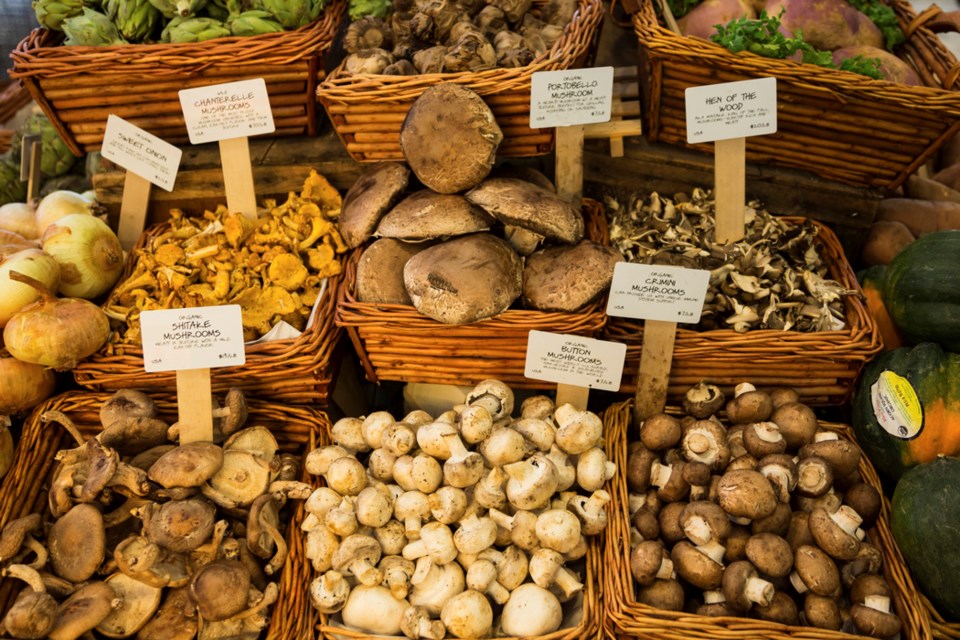Mushrooms are one of those foods that you either love or hate. It’s too bad for those who haven’t acquired a taste for these fun fungi, as there are many different varieties around the world used for whatever ails you. You may have seen the ads for cancer-fighting and immune-boosting benefits, and in Vancouver it’s very rare to walk into a restaurant and not see them on the menu, especially in Asian cuisine.
But whatever side of the fungi fence you’re on, you can’t deny that there is something special – and even mystical – about these marvelous mushrooms.
Now, as I am sure you are aware, there are good mushrooms and there are bad mushrooms, and when I say bad, I mean slow-painful-death bad (or quick, depending on the mushroom). It is not as fun as Alice in Wonderland may have led you to believe.
There are a variety of wild edible mushrooms out there if you know where to look. The oyster mushroom, blue chanterelle and cauliflower mushroom are just a few of the varieties that can be found locally and safely identified (although I encourage you to take an educated tour which are available all over the city before you dive into foraging). And FYI, it’s illegal to forage mushrooms in BC parks, so you might want to start off with the farmers’ market.
It’s fair to say that you are taking a risk by foraging your own mushrooms – there are folks that definitely know what they are doing, but even experts can accidentally poison themselves by making an unfortunate mistake. Mushrooms aren’t quite like snowflakes – they can be very similar to each other, making it hard to pick out the good from the bad.
Like many things in life, mushrooms are at the center of folklore and mysticism. For example, the red and white fly agaric – you know, that mushroom that you automatically picture a fairy sitting on top of – is believed to have been used by European shamans and religious leaders as a hallucinogenic. It contains two toxins that reduce the body’s response to fear and there is question whether or not warriors ingested it prior to battle. Fly agaric is still classified as poisonous, so don’t go hunting for them before your next big public speaking gig or Tinder date.
Another fungi folk tale is the appearance of a ring of mushrooms, known as fairy rings. It is said that this is where the fairies come to dance after it has rained (I am imagining a rave), and if a human enters this ring they may fall asleep for a hundred years or disappear. Fairies don’t like party crashers and become total downers when disturbed, apparently. Lame!
According to hieroglyphs from 4,600 years ago, the ancient Egyptians believed that mushrooms were the plant of immortality. The point being, mushrooms have been around for a very long time, and everyone has something to say about them.
With so many varieties around the world, mushrooms contain a variety of natural medicines. Some are known to have antibacterial and antiviral properties. Even toxic mushrooms that use their poison to protect themselves from predators can be used to produce environmentally friendly pesticides.
Mushrooms can help with weight management, build your immune system, and even increase your vitamin D levels, as well as having anti-inflammatory properties.
They are pretty bad ass, and you can prepare them in so many ways. Of course, it’s always good to check with a professional before using them for medicinal purposes, but if you get the go-ahead, the world is your oyster...mushroom. Get it?
Vegan Mushroom Soup
Ingredients
4 cups vegetable broth
½ package of soba noodles
6 ounces fresh shiitake mushrooms, stemmed and sliced
2 cloves of garlic crushed
1 grated carrot
2 tsp minced fresh ginger, to taste
2 to 3 baby bok choy, with leaves, sliced
3 to 4 green onion, sliced
1/4 cup minced fresh cilantro (or parsley)
1 tbsp tamarind sauce, or to taste
Freshly ground pepper and Himalayan salt to taste
Directions
1. In a medium size pot, combine the broth with 2 cups water to a rapid simmer.
2. Break the soba noodles into small pieces. Add the noodles, mushrooms, and ginger to the simmering broth. Cook until the noodles are al dente, about 3 to 4 minutes.
3. Add the bok choy, garlic, carrot, green onion, and cilantro, and cook for just 2 to 3 minutes longer. Season with tamarind sauce, salt and pepper, then serve.



